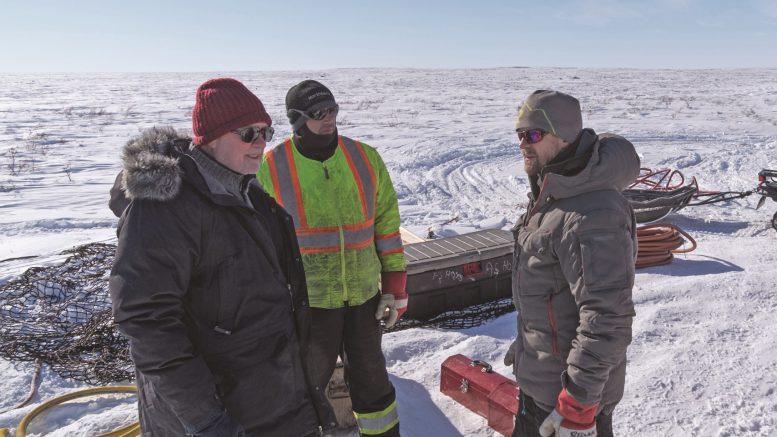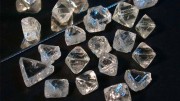The Covid-19 pandemic has choked off revenue for diamond producers and funding for diamond juniors for much of the year. But with the diamond trade slowly starting to reopen and buyers and sellers adjusting to life under the pandemic, some companies outside of the big two – De Beers and Alrosa – have proven to be resilient. Here’s a look at seven small diamond producers and explorers that are soldiering on.
Gem Diamonds
Gem Diamonds‘ (LSE: GEMD) Letseng mine in Lesotho, known to host large, high-quality Type II diamonds, has continued to deliver exceptional diamonds this year, with 12 diamonds larger than 100 carats recovered to date. The latest stones included a 442-carat diamond Type II stone in August, and 233-carat and 166-carat Type II white diamonds in September.
Production at the Letseng open-pit mine was suspended for 30 days early in the pandemic, but resumed in late April. On the sales side, Gem has been successful in adopting flexible tender processes to continue diamond sales during travel restrictions associated with the pandemic. Its average sales price for the first half of 2020 was US$1,707 per carat on 43,384 carats sold.
The company reported a net loss of US$1.7 million for the first half of 2020 on revenue of US$69.5 million. That compares with US$4.2 million in net earnings on US$91.3 million in revenue in the comparable period of 2019. It ended the first half with cash reserves of US$17.5 million and US$51.6 million in available debt facilities.
In its recent results, the company noted that it expects a recovery in the diamond market in the medium to long term as demand grows and supply shrinks, particularly in the higher quality categories. Gem has also achieved positive results from a business transformation program it launched in 2018. The company says the program has delivered US$65 million in benefits to date.
Lucara Diamond

Lucara’s Mothae diamond treatment plant in Lesotho. Credit: Lucara Diamond
With the global Covid-19 pandemic casting uncertainty on the global diamond market and its ability to generate revenue, Lucara Diamond (TSX: LUC) announced a supply agreement in July with HB Group for 10.8 carat-plus stones produced at its Karowe mine in Botswana.
Diamonds weighing more than 10.8 carats usually account for 70% of Lucara’s revenue; however, the company suspended sales of diamonds in the category in March.
The agreement, which will continue through 2020, will see HB acquire diamonds at a price based on the estimated polished outcome. Any difference will be accounted for after the achieved final sale of the polished stone, less a fee and the cost of manufacturing.
HB is an Antwerp-based, diamonds-focused technology company. Lucara said the deal will provide regular cash flow for the company and better sales prices than regular sales arrangements.
The company is also selling diamonds through its Clara digital platform, which has seen a growing customer base during the pandemic. The company completed five sales on Clara, which was up to 46 customers in August. It also had its first regular tender in Antwerp on June 18, as travel restrictions started to ease. During the second quarter, the company generated a total of US$7.5 million in revenue from both avenues, with sales restricted to stones under 10.8 carats.
Lucara’s Karowe open pit mine has continued to operate during the pandemic. The company reported a net loss of US$13.9 million on revenues of US$7.5 million for the second quarter, with 68,979 carats sold at an average price of US$109 per carat. Karowe produced 101,200 carats during the quarter, from 705,421 tonnes processed at an average grade of 14.3 carats per hundred tonnes.
Mountain Province Diamonds

At the Gahcho Kue diamond mine in the Northwest Territories. Credit: Mountain Province Diamonds.
In September, Mountain Province Diamonds (TSX: MPV) resumed traditional sales of diamonds while also doubling the value of its alternative sales agreement with Dunebridge Worldwide to $100 million.
The company holds a 49% interest in the Gahcho Kue diamond mine in the Northwest Territories, which is operated by 51%-owner De Beers. While the project has remained open during the pandemic, Mountain Province hasn’t been able to sell its portion of production, due to travel restrictions related to the virus.
The company held its first traditional sale since the start of the pandemic on Sept. 19 in Antwerp, with a second sale planned to close on Oct. 31. The initial sale brought in a modest US$8.9 million, from 210,661 carats sold at an average price of US$42 per carat.
The company also received shareholder approval to increase its sales agreement with Dunebridge Worldwide, originally announced in June, to $100 million. The agreement, which includes only run-of-mine diamonds under 10.8 carats, preserves upside potential in diamond prices for Mountain Province. While Dunebridge buys the diamonds at current market prices, the junior will participate in 50% of any future upside when the goods are sold. Dunebridge is controlled by Dermot Desmond, who owns about a third of Mountain Province’s shares.
In September, the company also received shareholder approval to transfer its US$25 million senior secured debt facility from existing lenders to Desmond, in effect, refinancing and extending the facility. The interest rate has been adjusted to 5% per year, payable monthly, and certain financial covenants have been removed for one year.
In the second quarter, Mountain Province reported revenue of $34 million at an average realized price of US$33 per carat, and a net loss of $26.8 million. Of the total sales, $30.6 million were sold to Dunebridge. The company noted that the 757,360 carats of diamonds sold do not represent normal run-of-mine production.
The company held $16.8 million in cash at the end of the quarter and a negative net working capital of $330.8 million.
North Arrow Minerals

North Arrow Minerals’ Mel project camp in Nunavut. Credit: North Arrow Minerals
In August, North Arrow Minerals (TSXV: NAR) received notice that its new partner, EHR Resources (ASX: EHX), had raised enough cash to fund a bulk sample at the junior’s Naujaat project in Nunavut next summer. The two companies signed an option agreement in June that will see EHR earn up to a 40% interest in Naujaat in return for a $5.6-million investment.
North Arrow is planning a 1,500-2,000-tonne bulk sample program that will take place between June and August 2021. The sample, which will be extracted from the 1.3-sq.-km Q1-4 kimberlite at Naujaat, will be shipped south and processed in the fourth quarter, with full results expected in the first quarter of 2022. North Arrow received $300,000 earlier in the year to supply the project by sealift in preparation for the sample.
Q1-4 is known to host rare orangey-yellow diamonds and has an inferred resource of 48.8 million tonnes grading 53.6 carats per hundred tonnes for 26.1 million carats. However, a bigger sample of diamonds is required to assess the population of coloured diamonds at Q1-4 and their value.
North Arrow and EHR also have a non-binding letter of intent to negotiate a second agreement under which EHR can earn an additional 20% interest in Naujaat by funding a 10,000-tonne bulk sample. The project is located 9 km northeast of the community of Naujaat.
Perth-based “diamond incubator” EHR Resources raised A$10.6 million (US$7.5 million) in August and recently announced the appointment of Kim Truter, the former CEO of De Beers Canada, as a non-executive director, and George Read, an executive with Star Diamond, as vice-president exploration.
This fall, North Arrow is also conducting a ground gravity survey at its wholly owned Loki diamond project in the Lac de Gras region of the Northwest Territories.
Pangolin Diamonds
In June, Botswana-focused Pangolin Diamonds (TSXV: PAN) received approval for a 500-tonne bulk sample program at its AK10 kimberlite.
The bulk sample will be extracted from underground by Pangolin’s joint-venture partner at the project, Makunwu Civil Blasting, via a vertical shaft that extends to a depth of 13 metres.
The shaft will be extended to a depth of 32 metres, with four horizontal drifts developed at the 15, 20, 25 and 30-metre levels to a maximum of 5 metres in each direction.
Pangolin plans to crush the bulk sample material to a maximum of 8 mm, and process it onsite using a dense media separation (DMS) plant.
The junior is earning a 75% interest from a private company in the project, located 4.4 km from Lucara Diamond‘s (TSX: LUC) Karowe mine. Under the agreement, signed in 2018, Pangolin is required to complete the sample by year-end. The company announced its intention to raise $600,000 through a private placement in June.
The company also plans to follow-up on the KW04-C dyke, discovered through soil sampling, and to drill its Kweneng project, which was discovered before Botswana’s pandemic-related lockdown earlier this year. Soil sampling revealed a 250- by 850-metre kimberlitic chromite anomaly with more than 50% of the chromites analyzed classified as diamond-inclusion type chromites. Drilling intersected a shallow, ultramafic hypabyssal dyke with a true width of 6 metres.
Follow-up work will include sampling to trace the extent of the dyke, sampling for microdiamond analysis, and a sample of up to 20 tonnes for macrodiamond analysis. Pangolin says the highly altered material recovered from the dyke appears similar to diamond-bearing bodies discovered 33 km away in the 1990s.
The company has also conducted field programs at its Malatswae and Motloutse projects this year that are expected to generate 10 to 15 drill targets.
Pangolin has a total of seven 100%-held projects in Botswana covering 107 sq. km of claims.
RJK Explorations
RJK Explorations (TSXV: RJX.A) announced its second discovery of a diamond-bearing kimberlite at its claims near Cobalt, Ont., in July. The company is searching for the source of the famous Nipissing yellow diamond, estimated at 700-800 carats, which was found nearby in the early-1900s.
The discovery, announced in July, was at the KON1 target, 400 metres south of the known KON kimberlite dyke. A 277-kg sample taken from KON1 returned 7 microdiamonds varying in colour from clear to white. The first hole into the target hit kimberlite, in several phases, from 11 metres depth to 100 metres depth. RJK plans to follow up with large-diameter core drilling.
RJK’s first find was announced in April at its Nipissing diamond project, where 18 microdiamonds were recovered from a 22.4-kg sample from the Paradis Pond target. The microdiamonds varied in colour, including clear white, yellow and light green.
The mini-bulk sample was actually a retest of four holes drilled at the target in 2019. The company noticed similarities between the Paradis Pond core and the core from KON1 (drilled early in the year) that prompted it to get the core retested at Chuck Fipke’s CF Mineral Research instead of the labs that did the original investigation.
In August and September, RJK followed up with more 10 more holes at Paradis Pond, which all intersected kimberlite, while microdiamond results are pending.
The Paradis kimberlite is described as a flat-lying formation unconformably draped on top of granitic bedrock and covered by shallow overburden. The kimberlite varies in true thickness from 7 metres to 16 metres.
A few more holes planned are planned for the year on both projects, and RJK is awaiting permits for further drilling.
The junior holds claims (both staked and optioned) totalling 170 sq. km in the Cobalt mining camp, in a well-established kimberlite field within the Lake Temiskaming Structural zone.
Star Diamond

Rio Tinto bulk sample at Star Diamond’s Star kimberlite in Saskatchewan. Credit: Star Diamond
Star Diamond (TSX: DIAM) will have its day in court with Rio Tinto (NYSE: RIO), which the junior has accused of invalidly exercising an option to earn 60% of its Star-Orion South project, 60 km east of Prince Albert, Saskatchewan.
The court date has not yet been set, but the junior started legal proceedings against Rio Tinto in March. In August, a Saskatchewan court quashed Rio Tinto’s petition to dismiss the suit.
The two companies signed a 7.5-year option agreement in 2017 that gave Rio Tinto the right to earn 60% of the project by spending a total of $75 million in four stages. Star has accused the major of “predatory practices,” misrepresenting the costs of Rio Tinto’s work program under the option agreement, and attempting to dilute the junior’s stake. Once Rio Tinto has earned 60% of Star-Orion, Star will have to fund its 40% share of project costs or see its ownership diluted.
Rio Tinto, which completed a 10-hole bulk sample at the project last year, gave Star notice in November that it was exercising all four options at once and ahead of schedule.
The major has proposed a $106-million program at the project this year, according to court documents.
Star is protected from having to raise funds for its portion of spending for at least several months. As it stands, Rio Tinto is prohibited from calling a meeting of the management committee under the JV agreement (where the budget would be set) until 120 days after it releases all results from the 2019 bulk sample. The sample is currently being processed at a facility built onsite by Rio Tinto.
At press time, Star Diamond had received and reported preliminary results from the first four holes of the bulk sample, with the remainder expected before the end of 2020. The fourth sample, weighing 1,179.4 tonnes, returned 3,005 commercial-sized diamonds weighing 131.82 carats at various grades of between 0.16 carats per hundred tonnes (cpht) to 12.9 cpht.
In total for the four samples reported to date, 505.45 carats have been recovered from 5,219.65 tonnes, with the largest diamond recovered so far weighing 6.28 carats.
Star Diamond says the results are in line with historical grades from underground bulk sampling and large-diameter drilling at the Star kimberlite. However, in a news release, Star Diamond’s president and CEO Ken MacNeill said the junior believes that the novel technology Rio Tinto used to excavate the bulk sample (a trench cutting rig adapted from civil engineering applications) has caused “undue diamond breakage” in the recovered diamonds.
A 2018 preliminary economic study on Star-Orion South outlines a $1.4-billion project that could produce 66 million carats over 34 years.




Be the first to comment on "Diamonds Snapshot: Seven small diamond producers and explorers to watch"